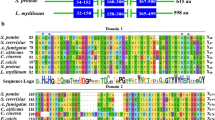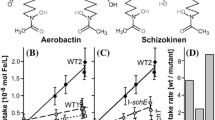Abstract
While in fungi iron transport via hydroxamate siderophores has been amply proven, iron transport via enterobactin is largely unknown. Enterobactin is a catecholate-type siderophore produced by several enterobacterial genera grown in severe iron deprivation. By using the KanMX disruption module in vector pUG6 in a fet3Δ background of Saccharomyces cerevisiae we were able to disrupt the gene YOL158c Sce of the major facilitator super family (MFS) which has been previously described as a gene encoding a membrane transporter of unknown function. Contrary to the parental strain, the disruptant was unable to utilize ferric enterobactin in growth promotion tests and in transport assays using 55Fe-enterobactin. All other siderophore transport properties remained unaffected. The results are evidence that in S. cerevisiae the YOL158c Sce gene of the major facilitator super family, now designated ENB1, encodes a transporter protein (Enb1p), which specifically recognizes and transports enterobactin.
Similar content being viewed by others
References
Albrecht-Gary A, Crumbliss AL. 1998Coordination chemistry of siderophores: Thermodynamics and kinetics of iron chelation and release. In: Sigel A, Sigel H, eds. Metal Ions in Biological Systems, Vol 35. Iron Transport and Storage in Microorganisms, Plants and Animals. New York: Marcel Dekker; 239–327.
Askwith CC, de Silva D, Kaplan J. 1996 Molecular biology of iron acquisition in Saccharomyces cerevisiae. Molec Microbiol 20, 27–34.
Berner I, Greiner M, Metzger J, Jung G, Winkelmann G. 1991 Identification of enterobactin and linear dihydroxybenzoylserine compounds by HPLC and ion spray mass spectrometry (LC/MS and MS/MS). BioMetals 4, 113–118.
Berner I, and Winkelmann G. 1990 Ferrioxamine transport mutants and the identification of the ferrioxamine receptor protein (FoxA) in Erwinia herbicola (Enterobacter agglomerans). BioMetals 2, 197–202.
Braun V, Hantke K. 1997 Receptor-mediated bacterial iron transport. In: Winkelmann G, Carrano CJ, eds. Transition Metals in Microbial Metabolism. Amsterdam: Harwood Academic Publisher; 67–145.
Brickman TJ, McIntosh MA. 1992 Overexpression and purification of ferric enterobactin esterase from Escherichia coli. Demonstration of enzymatic hydrolysis of enterobactin and its iron complex. J Biol Chem 267, 12350–12355.
Buchanan SK, Smith BS, Venkatramani L, Xia D, Esser L, Palnitkar M, Chakraborty R, van der Helm D, Deisenhofer J. 1999 Crystal structure of the outer membrane active transporter FepA from Escherichia coli. Nature Struct Biol 6, 56–63.
Dancis A, Klausner RD, Hinnebusch AG, Barriocanal JG. 1990 Genetic evidence that ferric reductase is required for iron uptake in Saccharomyces cerevisiae. Mol Cell Biol 10, 2294–2301.
Drechsel H, and Winkelmann G. 1997 Iron chelation and siderophores, In: Winkelmann G, Carrano CJ, eds. Transition Metals in Microbial Metabolism. Amsterdam: Harwood Academic Publishers; 1–49.
Duhme A, RC Hider, Khodr HH. 1997 Synthesis and iron-binding properties of protochelin, the tris(catecholamide) siderophore of Azotobacter vinelandii. Chem Ber /Recueil 130, 969–973.
Emery T. 1976Fungal ornithine esterases: relationship to iron transport. Biochemistry 15, 2723–2728.
Ernst JF, Bennet L, Rothfield LI. 1978 Constitutive expression of the iron-enterochelin and ferrichrome uptake systems in a mutant strain of Salmonella typhimurium. J Bacteriol 135, 928–934.
Ferguson AD, Hofmann E, Coulton JW, Diederichs K, Welte W. 1998 Siderophore-mediated iron transport: Crystal structure of FhA with bound lipopolysaccharide. Science 282, 2215–2220.
Goodell B, Jellison J, Liu J, Daniel G, Paszcczynski A, Fekete F, Krisnamurthu S, Jun L, Xu G. 1997 Low molecular weight chelators and phenolic compounds isolated from wood decay fungi and their role in the fungal biodegradation of wood. J Biotechnol 53, 133–162.
Goffeau A, Park J, Paulsen IT, Jonniaux J-L, Dinh T, Mordant P, Saier MH. 1997 Multidrug-resistant transport proteins in yeast: complete inventory and phylogenetic characterization of yeast open reading frames within the major facilitator superfamily. Yeast 13, 43–54.
Hantke K. 1990 Dihydroxybenzoylserine-a siderophore for E. coli. FEMS Microbiol Lett 67, 5–8.
Heymann P, Ernst JF, Winkelmann G. 1999 Identification of a fungal triacetylfusarinine C siderophore transport gene (TAF1) in Saccharomyces cerevisiae as a member of the major facilitator superfamily. BioMetals 12 (in press, please include).
Heymann P, Ernst JF, Winkelmann G. 2000 Identification and substrate specificity of a ferrichrome-type siderophore transporter (ARN1p) in Saccharomyces cerevisiae (submitted).
Howard DH. 1999 Acquisition, transport and storage of iron by pathogenic fungi. Clin Microbiol Rev 12, 394–404.
Huschka H, Winkelmann G. 1989 Iron limitation and its effect on membrane proteins and siderophore transport in Neurospora crassa. BioMetals 2, 108–113.
Huschka H, Müller G, Winkelmann G. 1983 The membrane potential is the driving force for siderophore iron transport in fungi. FEMS Microbiol Lett 20, 125–129.
Huschka H, Naegeli HU, Leuenberger-Ryf H, Keller-Schierlein W, Winkelmann G. 1985. Evidence for a common siderophore transport system but different siderophore receptors in Neurospora crassa. J Bacteriol 162, 715–721.
Huschka H, Jalal MAF, van der Helm D, Winkelmann G. 1986 Molecular recognition of siderophores in fungi: Role of ironsurrounding N-acyl residues and the peptide backbone during membrane transport in Neurospora crassa. J Bacteriol 167, 1020–1024.
Lesuisse E, Labbe P. 1994 Reductive iron assimilation in Saccharomyces cerevisiae. In: Winkelmann G, Winge DR, eds. Metal Ions in Fungi. New York: Marcel Dekker; 149–178.
Lesuisse E, Simon-Casteras M, Labbe P. 1998 Siderophoremediated iron uptake in Saccharomyces cerevisiae: the SIT1 gene encodes a ferrioxamine B permease that belongs to the major facilitator superfamily. Microbiology 144, 3455–3462.
Leong SA, Winkelmann G. 1998 Molecular biology of iron transport in fungi. In: Sigel A, Sigel H, eds. Metal Ions in Biological Systems, Vol. 35, New York: Marcel Dekker; 147–186.
Mademidis A, Killmann H, Kraas W, Flechsler I, Jung G, Braun V. 1997 ATP-dependent ferric hydroxamate transport system in Escherichia coli: periplasmic FhuD interacts with a periplasmic and with a transmembrane/cytoplasmic region of the integral membrane protein FhuB, as revealed by competitive peptide mapping. Mol Microbiol 26, 1109–1123.
Nelissen B, De Wachter R, Goffeau A. 1997 Classification of all putative permeases and other membrane plurispanners of the major facilitator superfamily encoded by the complete genome of Saccharomyces cerevisiae. FEMS Microbiol Lett 21, 113–134.
Neilands J B, Konopka K, Schwyn B, Coy M, Francis RT, Paw BH, Bagg A. 1987 Comparative Biochemistry of microbial iron assimilation. In: Winkelmann G, van der Helm D, Neilands JB, eds. Iron Transport in Microbes, Plants and Animals, Weinheim: VCH-Wiley; 3–33.
O'Brian IG, Gibson F. 1970 The structure of enterochelin and related 2,3-dihydroxy-N-benzoylserine conjugates from Escherichia coli. Biochim Biophys Acta 215, 393–402
Pao SS, Paulsen IT, Saier Jr MH. 1998 Major facilitator superfamily. Microbiol Molec Biol Rev 62, 1–34.
Pollack JR, Neilands JB. 1970 Enterobactin, an iron transport compound from Salmonella typhimurium. Biochem Biophys Res Commun 5, 989–992.
Telford JR, Leary JA, Tunstad LMG, Byers BR, Raymond KN. 1994 Amonabactin: Characterization of a series of siderophores from Aeromonas hydrophila. J Am Chem Soc 116, 4499–4500.
Van der Helm D, Winkelmann G. 1994 Hydroxamates and polycarboxylates as iron transport agents (siderophores) in fungi. In: Winkelmann G, Winge DR, eds. Metal Ions in Fungi. New York: Marcel Dekker; 39–98.
Wach A, Brachat A, Pohlmann R, Philippsen P. 1994 New heterologous modules for classical or PCR-based gene disruptions in Saccharomyces cerevisiae. Yeast 10, 1793–1808.
Wiebe C, Winkelmann G. 1975 Kinetic studies on the specificity of chelate-iron uptake in Aspergillus. J Bacteriol 123, 837–842.
Winkelmann G. 1979 Evidence for stereospecific uptake of iron chelates in fungi. FEBS Lett 97, 43–46.
Winkelmann G. (ed.) 1991 Handbook of Microbial Iron ChelatesBoca Raton FL: CRC Press.
Winkelmann G. 1993 Kinetics, energetics, and mechanisms of siderophore iron transport in fungi. In: Barton LL, Hemming BC, eds. Iron Chelation in Plants and Soil Organisms, San Diego: Academic Press; 219–239.
Winkelmann G, Braun V. 1981 Stereoselective recognition of ferrichrome by fungi and bacteria. FEMS Microbiol Lett 11, 237–241.
Winkelmann G, Huschka H 1984. A study on the mechanism of siderophore transport-a proton symport. J Plant Nutr 7, 479–487.
Winkelmann G., and D.R. Winge. (eds.) 1994 Metal Ions in Fungi. New York: Marcel Dekker.
Winkelmann G, Cansier A, Beck W, Jung G. 1994 HPLC separation of enterobactin and linear 2,3-dihydroxybenzoylserine derivatives: a study on mutants of Escherichia coli defective in regulation (fur), esterase (fes) and transport (fepA). BioMetals 7, 149–154.
Winkelmann G, Drechsel H. 1997 Microbial siderophores. In: Kleinkauf H, von Döhren H, eds, Biotechnology, 2nd ed., Vol. 7, Weinheim VCH-Wiley; 199–264.
Rights and permissions
About this article
Cite this article
Heymann, P., Ernst, J.F. & Winkelmann, G. A gene of the major facilitator superfamily encodes a transporter for enterobactin (Enb1p) in Saccharomyces cerevisiae. Biometals 13, 65–72 (2000). https://doi.org/10.1023/A:1009250017785
Issue Date:
DOI: https://doi.org/10.1023/A:1009250017785




